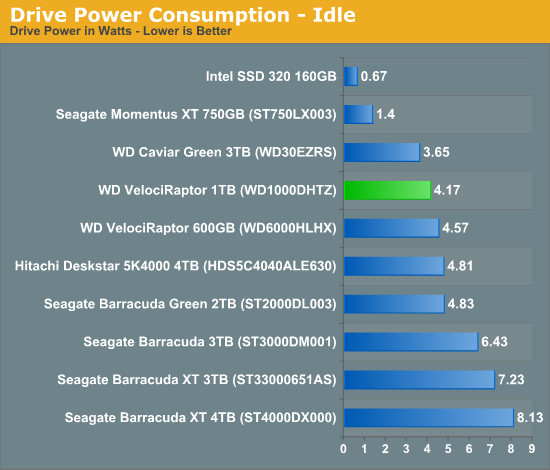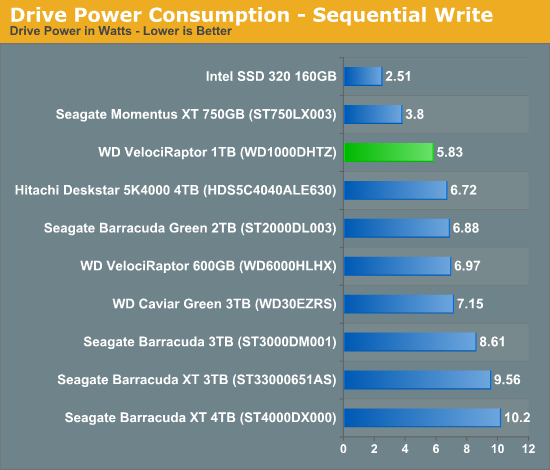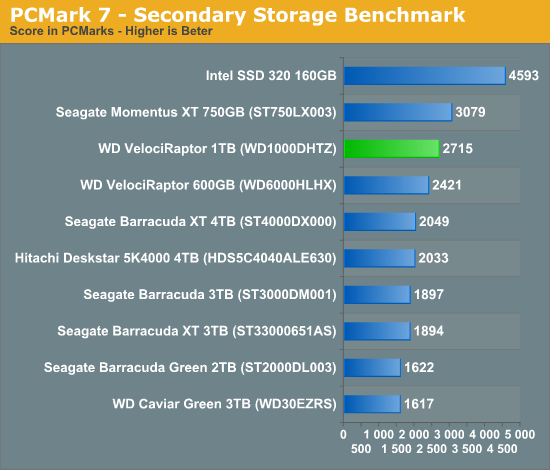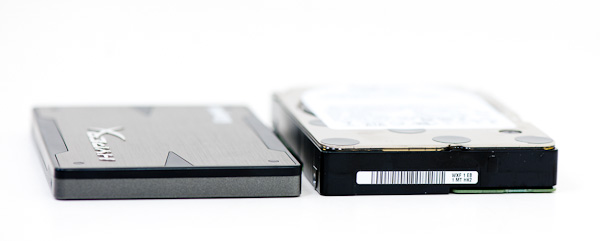Western Digital VelociRaptor 1TB (WD1000DHTZ) Review
by Anand Lal Shimpi on April 16, 2012 8:00 AM EST- Posted in
- Storage
- HDDs
- Western Digital
- VelociRaptor
PCMark 7 Performance
For workloads that are particularly read intensive and small enough to make good use of the on-board NAND, the Momentus XT cannot be beat. The VelociRaptor does come very close however, and it does win in enough other benchmarks to make it clearly the better overall performer. Philosophically I understand why Western Digital opted against equipping the VR with any NAND (cached operations do sort of defeat the purpose of having a 10,000 RPM spindle speed), but that doesn't change the fact that it would've made for one pretty impressive hard drive.
Power Consumption
Despite its 2.5" form factor (the drive itself), the VelociRaptor's 15mm height prevented it from being used as a notebook drive. Even if you had a thick enough notebook, the VR's power consumption is more in-line with a 5400RPM 3.5" drive than a standard 2.5" mobile drive. That being said, as a 10,000RPM 3.5" drive the VelociRaptor is quite power efficient. Idle power is competitive with WD's Caviar Green (and lower in the case of load power).
Power consumption is down compared to the previous generation as well. Once again, compared to an SSD however the drive isn't anywhere near efficient.














92 Comments
View All Comments
TiGr1982 - Tuesday, April 17, 2012 - link
I've read similar feedback from the person running 6 years old Raptor. He wrote the same - S.M.A.R.T. is fully clean after 6 years of intensive use. If so, Raptor robustness and longevity deserves real respect.Casper42 - Monday, April 16, 2012 - link
I can still see this being used in a decent gaming rig.120 / 160GB SATA 6Gb SSD for OS and Basic Apps
500GB / 1TB VR333M for Games (my Steam folder just keeps growing and growing) and any Video Editing
2 / 3 / 4 TB "Green" drive for Data Files and to backup (offline) the SSD occasionally.
Then a SATA Optical drive as well.
All that fits easily in most mATX Cases and only needs 4 SATA connections.
I am running a 64GB / 600GB VR / 2 x 2TB Green setup in my main machine currently and I can say it works very well. Most FPS style games these days are very sequential Reads because when you load a map its usually a several hundred MB file which Windows will try to keep sequential (defragged)
MichaelD - Monday, April 16, 2012 - link
I finally moved to a SSD for a System drive a few months ago; awesome improvement. However, many gamers (like me) looking for a fast drive to load games from can't afford a large SSD.I have a 150GB Velociraptor from a few years back; it can't hold all my games so I'm not using it. The new 500GB model is exactly what I've been waiting for; and it's at a reasonable pricepoint too. I haven't found any online yet. Any idea where to look and when they'd be available?
patpro - Tuesday, April 17, 2012 - link
Unfortunately, the solution consisting in pairing a SSD with a HDD is mostly "Windows only". I'm using Mac OS X, FreeBSD, and Linux (on different computers), and there is no consumer product for me to create a bundle of SSD/HDD with a software caching solution. Needless to say I'm a big advocate of hardware solutions, anything that would work without installing a dedicated software on the OS.Hard drives with 32 or 34 GB nand flash read/write cache on top of good old platters would be so great...
Traciatim - Tuesday, April 17, 2012 - link
Is there any way you can test drives in real world scenarios? Sure 4K random reads are nice to show the differences between SSD's and Platters, but in the real world how many scenarios are you really going to see that kind of data access?It would be nice if you would run something like Ultimate Defrag and run through some common level load tests games, boot times, Launch three applications sequentially, launch three applications at the same time, a virus scan, and all kinds of other common tasks like these.
MichaelD - Tuesday, April 17, 2012 - link
After reading the comments about the Seagate Momentus XT drives, I did some research and was pretty blown away. The XTs truly seem like the drives to beat. The responsiveness of a SSD with the capacity of a platter-based HD for a very reasonable price. A certain egg-ish etailer even has a sale on them ATM. I bought two of the 500GB drives last night. One for my netbook to replace it's 5400-rpm drive and the other to load my games from on my PC. Thanks for pointing out the XT drives, guys!TiGr1982 - Tuesday, April 17, 2012 - link
Indeed, Seagate Momentus XT IS the way to go for upgrade. Recently I upgraded my laptop (Acer 7552G, Win 7 SP1, AMD Danube platform, SB850 southbridge) with Seagate Momentus XT 750 GB, and now it runs MUCH faster than before, because HDD is no longer the bottleneck. I hope, so will be the case for you :)The only probable caveat is there can be compatibility issues with Momentus XT, but, as far as I know, these problems can happen only on Mac laptops, not PC laptops.
TiGr1982 - Tuesday, April 17, 2012 - link
These are my 2 cents. Everybody, including Anand himself, is complaining about the absence of NAND flash in new Raptors. My personal opinion is as follows: WD ARE HDD guru's, and their overall HDD market record is nice, but, probably, up to now, they didn't make the proper R'n'D effort to integrate the NAND. So now, looking at Seagate, even if they appreciate the advantage of employing internal NAND in HDD for caching, they can't catch up easily.Obviously, looking "under the hood", soldering the NAND flash to the HDD PCB is surely not enough; you need the SSD controller for this NAND and, more important, you need the proper firmware to use this NAND reasonably, together with the main storage, i.e. disk platters. I believe, developing of this firmware itself is not so simple. Recall that Seagate was polishing the firmware for the first gen Momentus XT (500 GB, 4 GB NAND) for around a year AFTER its actual release on the market. Same thing probably will happen with the second gen of Momentus XT (750 GB, 8 GB NAND) . This circumstance clearly points out that even in Seagate case, the whole hybrid tech is in the intermediate, but not final, stage.
Also, recall that Seagate started experimenting with flash in HDD in Windows Vista times, with Momentus PSD, around 2007, which is an "ancient time" on computer hardware timescale.
So, what do you want from WD? :)
TiGr1982 - Tuesday, April 17, 2012 - link
Saying, R'n'D, I actually meant R&D, just the notations, you understand :)JimmiG - Wednesday, April 18, 2012 - link
I went with a standard 7200 RPM, 1TB drive and then added a 64GB OCZ Synapse Cache SSD. The SSD costs $100, so the total is still lower than the Velociraptor. It's the "dream" mentioned in the conclusion and it's already here (as long as you don't mind running Windows 7, and have the space for two drives).